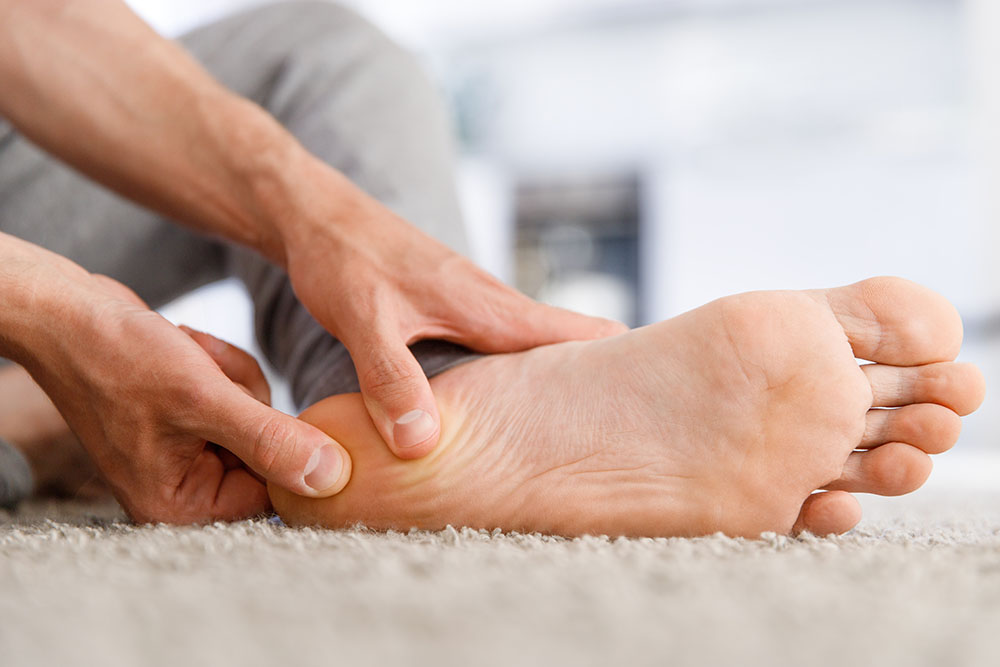
What Is Plantar Fasciitis?
Plantar fasciitis is a common condition that causes pain in the heel or bottom of the foot. It occurs when the plantar fascia—a thick band of tissue that supports the arch and connects your heel bone to your toes—becomes irritated or inflamed.
Request an AppointmentWho Is at Risk?
While plantar fasciitis can affect anyone, certain factors may increase your risk:
- Prolonged standing or walking: Jobs or activities that keep you on your feet for long periods can lead to strain.
- Unsupportive footwear: Shoes lacking proper arch support or cushioning can contribute to the problem.
- Foot mechanics: Flat feet, high arches, or abnormal walking patterns can increase stress on the plantar fascia.
- Excess body weight: Carrying extra weight puts added pressure on your feet.
- Age: Most common in people between the ages of 40 and 60.
Signs and Symptoms of Plantar Fasciitis
If you’re experiencing plantar fasciitis, you may notice:
- Heel pain: A sharp or aching pain, especially with your first steps in the morning or after sitting for a while.
- Foot stiffness: Difficulty walking due to tightness or tension in the foot.
- Swelling: Mild swelling or tenderness on the bottom of the foot near the heel.
What Causes It?
Plantar fasciitis is often the result of repetitive strain on the plantar fascia. Common causes include:
- Overuse: High-impact activities like running or jumping can overwork the fascia.
- Improper footwear: Shoes that lack arch support or don’t fit well can lead to problems.
- Reduced flexibility: As we age, the plantar fascia can become less elastic and more prone to injury.
Effective Treatment Options
The good news is that most cases of plantar fasciitis can be treated without surgery. Treatment options include:
- Rest and Ice
- Limit activities that aggravate the pain.
- Apply ice to the affected area for 15–20 minutes several times a day.
- Stretching Exercises
- Gentle stretches targeting the calf muscles and Achilles tendon can relieve tension.
- Supportive Footwear
- Wear shoes with good arch support and cushioning. Custom orthotics may also help.
- Over-the-Counter Medications
- Nonsteroidal anti-inflammatory drugs (NSAIDs), such as ibuprofen, can ease pain and reduce inflammation.
- Physical Therapy
- A physical therapist can guide you through exercises to strengthen your foot and improve flexibility.
- Night Splints
- These devices keep your foot gently stretched overnight to prevent morning pain.
- Steroid Injections
- In more severe cases, your doctor may recommend a corticosteroid injection to reduce inflammation.
How to Prevent Plantar Fasciitis
Taking preventive steps can help you avoid future flare-ups:
- Wear proper shoes: Choose footwear with good arch support and shock absorption.
- Stretch regularly: Especially before and after exercise.
- Maintain a healthy weight: Reducing pressure on your feet can prevent strain.
- Vary your workouts: Mix high-impact activities with low-impact options like swimming or cycling.
Ready to Treat Your Heel Pain?
Plantar fasciitis is a manageable condition with the right treatment and care. If you’re experiencing persistent heel pain, don’t wait—early intervention can help you avoid long-term discomfort. Consult with a healthcare provider to receive an accurate diagnosis and create a personalized treatment plan.
Take care of your feet—they carry you through life!
